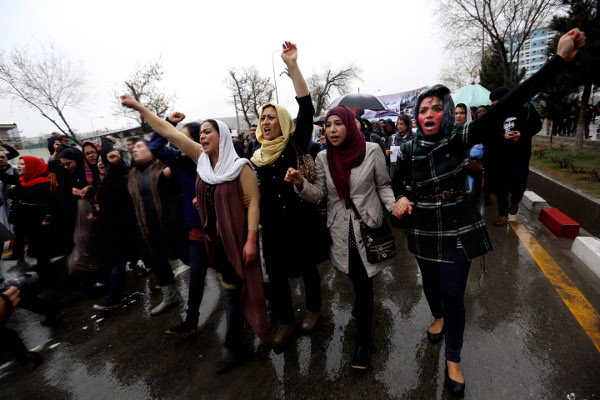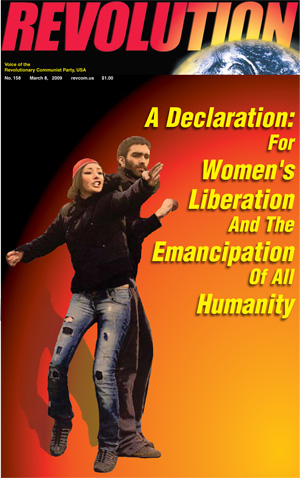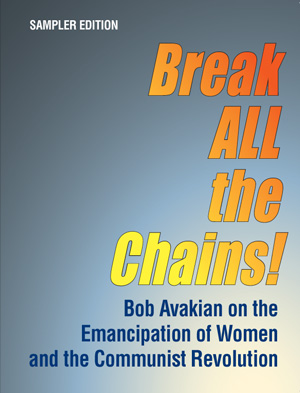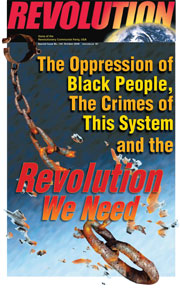From A World to Win News Service:
The Oppression of Women in Afghanistan and the Western-Appointed Regime
April 4, 2016 | Revolution Newspaper | revcom.us

It has been a year since the brutal murder of Farkhunda by a mob of men. She was accused of burning the Quran. Above: Afghan women protest the killing of Farkhunda, March 24, 2015. AP photo
March 28, 2016. A World to Win News Service. It has been a year since the brutal murder of Farkhunda by a mob of men. She was accused of burning the Quran. Government officials initially justified the murder, but as the people’s anger rose in Afghanistan and the world, they backed down—slightly. Many of the perpetrators are still free. The government seems reluctant to sentence the few still in prison and many of the initial sentences were overturned by the state court, which then imposed lighter sentences. Farkhunda’s mother, Bibi Hajera, expressed her frustration in a video message sent to the media on 8 March this year. She said, “This 8 March in Afghanistan is being celebrated at a time when justice for women in Afghanistan has been buried with Farkhunda forever. God give me patience because justice has not been done.” (BBC, March 8, 2016)
She was making a strong point, because the murder of Farkhunda was not the end of injustice for the women in Afghanistan and it has been followed by other shocking events.
In November 2015, Rokhshana, a 19-year-old woman in a village in the central province of Ghor accused of adultery, was stoned to death by a group of men, apparently after a local trial. According to the governor of Ghor, Seema Joyenda, “Rokhshana first ran away several years ago to Iran after her family tried to marry her off to an old man. After they brought her back, they forcibly married her off to another old man. When she ran away this time, she did so as a married woman, and was punished with stoning.” (Guardian, November 3, 2015)
In December, the husband of Reza Gul, a woman from Faryab province, cut off her nose and part of her upper lip with a knife. A similar incident happened to Setara, another Afghan woman, a year earlier. An 18 year-old from Samangan was killed by her father using a hatchet. According to the Afghanistan Independent Human Rights Commission, so-called “honour killings” rose in the six months from March to September 2015. Out of the 190 women known to have been murdered in Afghanistan during this period, 101 were registered as honor killings. These are only samples of many more and perhaps thousands of similar cases of violence against women on a daily basis.
Even though only a small fraction of cases of domestic violence against women gets registered, and many forms of violence (for example, psychological and verbal violence) are not considered as such, still more than 5,000 cases have been registered, according to a report by the Afghanistan Independent Human Rights Commission. The same report indicates a five percent increase with respect to the previous year, after a 20 percent rise a year earlier. The same report indicates that the dimensions of violence are more horrific and the perpetrators are younger.

Download the PDF of this pamphlet: A Declaration: For Women's Liberation and the Emancipation of All Humanity
Some perpetrators have been arrested but many thousands are free, and they feel safe to continue committing crimes against women, even though those women could be their wife, daughter, sister or mother. They see the law, religion, tradition and the authorities on their side. According to Human Rights Watch, 90 percent of Afghan women have been victims of violence. Only a fraction of cases in which women are killed are treated as murder, and in only less than 30 percent of the cases are the killers arrested. Most can escape even a trial.
Since the Islamic regime was first set up by the U.S. and other Western imperialists in 2001, with a new U.S.-brokered government installed in 2015, Western political leaders have been giving the impression of a gradual improvement in the status of women in Afghanistan. The Western mainstream media continuously report the number of women members of Parliament, the number of women in the government cabinet or the number of women governors. The reports mainly compare women’s situation now with that under the Taliban. It is true that during the religious fundamentalist rule of the Taliban and, before that, the rule of the Mujahideen warlords in the 1990s, the situation for women in Afghanistan was especially harsh. Women’s rights were tremendously restricted, and their oppression took its most open form.
The Mujahideen (who had fought the occupation of Afghanistan by the Soviet Union, the U.S.’s main imperialist rival) came to power with strong military, financial and political support from the U.S. and other Western imperialists. As each warlord established relations with a different regional power, they were eventually dumped by the imperialists. Then the Taliban took over the country with military and political support by U.S. allies such as Pakistan and Saudi Arabia. Girls were banned from going to school, and many more restrictions were imposed on women, especially outside the home. In fact the U.S. and the West bear a big responsibility for what happened to women during both the Mujahideen and Taliban periods.
When the U.S. and the West, based on their global interests, decided to remove the Taliban from power, suddenly they remembered that these forces oppressed women and used this to justify their brutal invasion of Afghanistan under the pretext of liberating women.
Now Western politicians and the loyal media have decided to take into account the history of women during the Taliban era, comparing women’s situation today with that under the Taliban as if there were no history before that and subsequent “achievements” should be judged by that standard. Now, under the U.S.-led occupation, a section of women living in Kabul and maybe some other big cities might be able to work outside the home, but they still face tremendous danger, pressure and discrimination. The situation of the vast majority of women is not better, and likely worse. The only other so-called achievement of the new regime is allowing schools for girls to open. In reality, this has not affected millions of children who are too scared or too poor to go to school. Women’s situation under the current regime has a long way to go before even catching up with the situation during the 1970s and ’80s.
This worsening situation is blamed on the armed opposition groups, mainly Taliban because they have gained control over increasing parts of Afghanistan. Apart from that, it is also blamed on the “conservative society.” These are both ways of arguing that the government and the whole apparatus that was installed and structured in Afghanistan by the Western imperialist powers is on the side of women’s rights. This is a very false picture. They have done nothing to fundamentally change women’s situation, but have done many things to make sure that the oppression of women continues in some of its ugliest forms.
When the heart-breaking video of the stoning of young Rokhshana was circulating on social media, the regime claimed that this incident took place in a district under Taliban rule. But some activists in Kabul doubt this: “Usually, they are putting it on the Taliban to cover up their own kind.” (Guardian, November 3, 2015) Even if we assume that the stoning was in a Taliban-controlled area, the regime has tried hard to reintroduce the same kind of measures into law and compete with the Taliban in applying Sharia (Islamic law). Several weeks after the stoning, a local governmental court punished Zarmina and Ahmad, young lovers in the same province of Ghor, because they ran away from home. When the news reflected badly on the regime internationally, the government again tried to distance itself and blame it on the local courts and the conservatism that prevails in the society.
But the regime and its political base support this conservatism and backward ideas by enforcing backward laws through backward courts. At one point, the Afghan regime introduced a draft penal code that included “a proposal to restore stoning as punishment for adultery,” and the same report concludes that “tackling violence against women does not seem to be high on the Afghan authorities’ agenda.” (Amnesty International UK, posted November 25, 2013)
“Half the female prison population are convicted of ‘moral crimes’—which include running away from violent husbands, fathers or in-laws. Federal law is universally ignored in the local courts, where nearly 90 percent of all criminal and civil legal disputes are settled, and where girls are bartered to settle family disputes and a man who kills his wife can expect a fine.” (Guardian, January 13, 2013)
At the same time, “It is estimated the U.S. government put $15 million (£9.3 m) into supporting the ‘informal justice’ sector last year, entrenching the repressive mentality. In April 2011, the Afghan government sought to reintroduce public morality laws, regulation was drafted to impose wedding codes to ensure that brides were modestly dressed, to ban music at weddings and to prevent male and female guests mixing. Shops were to be fined for selling inappropriate wedding clothes.” (Guardian, January 13, 2013)
If financial aid (not to mention legitimacy) for local and unofficial courts and the introduction of this kind of repressive laws against women are not in line with religious fundamentalism, then what is it? The whole structure of the Afghan state and its organs, including the government, parliament, courts and religious institutions, are coordinated to provide the conditions for conservatism and institutionalize conservatism and fundamentalism, and as a result strengthen and enforce the anti-women mentality in the name of what some people in the West would call “the tradition and culture of the people of Afghanistan”.
These are clear advantages to men and a basis for their support of the patriarchal system and its promotion of violence against women. But the rise of violence against women in successively more horrific forms is not accidental or due to uncontrolled factors. It is a direct result of the policies of the regime and its backers, despite gestures such as the adoption of the UN agreement concerning the Elimination of Violence Against Women (EVAW) in 2009.
Today it is not uncommon for young women to set themselves on fire or commit suicide in some other way because they are trapped in domestic violence with no one to turn to. Some seek refuge in shelters or so-called safe houses that are not that safe. Because these places house the most vulnerable girls and young women, they are occasionally raided by various military forces who consider the women in the shelter immoral. In some cases, powerful local commanders or officials pop in to abuse and harass terrified women. Despite all this, some women see these places as an alternative to self-immolation. However, there are not enough shelters for even a small fraction of victims.
“Mariam, which is not her real name, has been hiding in a secret women’s shelter in Kabul for the past two months. She lives with around 20 women who have travelled here from across Afghanistan, each with their own horrific story of abuse. Some have left violent husbands. Others have been raped or are fleeing forced marriages arranged by their parents. All of them are terrified that they will be killed by their families.” (Aljazeera, July 3, 2015)
Powerful leaders and lawmakers make various excuses to close them, such as insufficient security personnel or financial difficulties, but the real intention is to shut down even the smallest way out of hell for women. Nazir Ahmad Hanafi, a member of the Afghan parliament representing the western city of Herat and a notorious advocate of anti-women laws, declared, “These so-called ‘safe houses’ are very bad... They protect people who are doing wrong things and give them immunity. They open the gates to social problems like AIDS.” (Aljazeera, July 3, 2015)
The continuing vicious state-organized abuse of women has many other aspects. The latest report by the Afghanistan Independent Human Rights Commission, endorsed by Human Rights Watch and released on 8 March this year, reveals that women prisoners are systematically and frequently subjected to forced virginity tests. That includes girls as young as 13, and they are not only conducted by force but in the presence of many people and in an invasive manner. In fact it is a form of torture to punish women who have fled violence, since the majority of women in Afghan prisons have been charged with so-called “moral crimes” that include running away from home—either with a lover or to escape forced marriage or domestic violence. These women are charged and convicted by the local courts that receive direct financial support from the U.S. government.
One of the authors of the report, Soraya Sobhrang, says that not only the prisons but also “women’s shelters are sending women for the tests, the Ministry of Women’s Affairs is sending them and the police are sending them.” (New York Times, March 6, 2016). This shows that these “tests” are a routine practice by governmental institutions aimed at already abused women. It has a particular ideological meaning. These “tests” mean that the authorities on every level consider these women guilty unless proven otherwise. Unfortunately, the report mainly emphasizes the unreliability of such “tests” and fails to emphasize that they are an unjustifiable act of violence, as is the arrest of these women in the first place.
The fact is that despite cosmetic measures, the situation for women is getting worse in many aspects. In particular violence against women is spiraling upward. The Taliban continue to oppress women in the harshest way in the areas under their control. The entire structure of the state installed by the U.S. and other Western imperialists and the current regime that the U.S. directly brought to power is increasingly harsh in its treatment of women. In fact, patriarchy is institutionalized and Afghan leaders are doing all they can to consolidate it by restoring and encouraging the most backward anti-women laws such as stoning, and putting restrictions on women’s private lives, on their activities and reducing their self-confidence by denying their most basic rights. There is literally no support for women who are victims of abuse or who flee domestic violence. Instead, they are arrested, imprisoned, tortured and punished, even in the shelters run by government organizations.
While women running away from violence and the threat of death from her husband and family for so much as talking to a man of her choice are arrested and imprisoned by the authorities, men who murder a woman in the name of “honor” are usually not arrested, and if they are, often serve less than two years in prison at most.
The regime legitimizes its anti-woman laws and policies in the name of respecting the culture and tradition of the people. These relations and ideas and practices correspond to the relations of production, the economic relations around which the society is organized, an economy that is in turn deeply embedded in the global capitalist system and imperialist power relations. The Afghan ruling class, like any reactionary ruling class, represents those relations and the ideas that arise from, justify and reinforce that exploitation and oppression. It cannot and will not seek to change these relations and the tradition and culture associated with them, but instead needs and seeks to consolidate and reinforce them, in old and new forms. The degradation of women and their status as the property and slave of men is a pillar of its rule and a condition for its existence.
Further, this regime is also connected to other, far more powerful extremely reactionary regimes, particularly Pakistan and Saudi Arabia, and its existence depends on world imperialism. Imperialism does not seek to and cannot liberate women in the countries it dominates, any more than it can eliminate male supremacy in its home countries.
Women’s liberation requires the abolition of classes, the social relations such as women’s oppression by men that go along with production relations based on exploitation, and the uprooting of all the ideas and practices that arise from and enforce these relations—in other words, a communist world. In a revolutionary society with a revolutionary state, starting immediately, women and men can be encouraged and protected to cast off such chains of the past—examining, debating, criticizing and where necessary uprooting old relations and ideas as part of creating a new society and a transformed, emancipating culture.
There are signs that women and especially young women in Afghanistan are increasingly defying these rotten and backward traditions, despite the high price they have to pay. But they must be organized to fight consciously for their liberation. The revolutionary and communist forces must rely on this highly oppressed section of people to wage and intensify their struggle for emancipation.
Volunteers Needed... for revcom.us and Revolution
If you like this article, subscribe, donate to and sustain Revolution newspaper.








